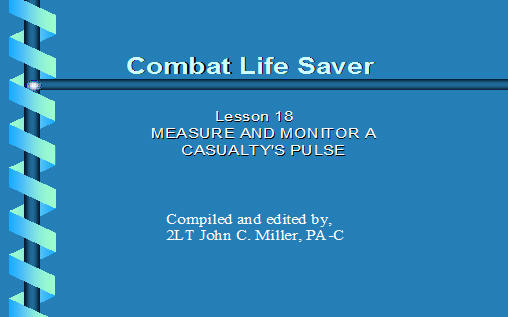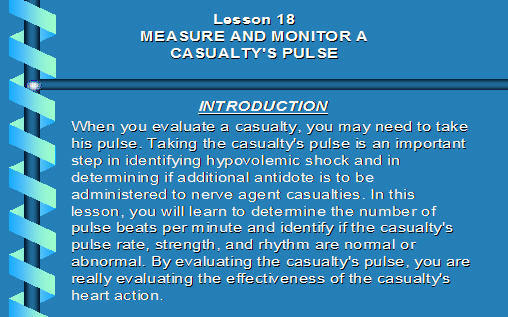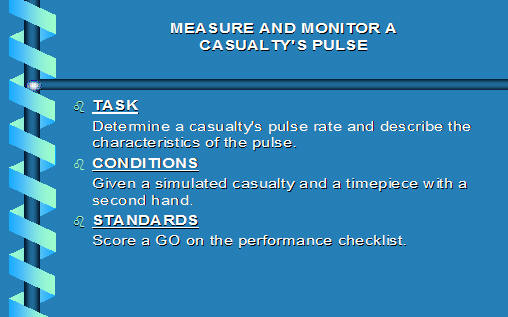MEASURE AND MONITOR A CASUALTY'S PULSE
Click here to download the presentation.



Lesson 18
MEASURE AND MONITOR A
CASUALTY’S PULSE
INTRODUCTION
When you evaluate a casualty, you may need to take his pulse. Taking the casualty’s pulse is an important step in identifying hypovolemic shock and in determining if additional antidote is to be administered to nerve agent casualties. In this lesson, you will learn to determine the number of pulse beats per minute and identify if the casualty’s pulse rate, strength, and rhythm are normal or abnormal. By evaluating the casualty’s pulse, you are really evaluating the effectiveness of the casualty’s heart action.
MEASURE AND MONITOR A
CASUALTY’S PULSE
TASK
Determine a casualty’s pulse rate and describe the characteristics of the pulse.
CONDITIONS
Given a simulated casualty and a timepiece with a second hand.
STANDARDS
Score a GO on the performance checklist.
LOCATE THE PULSE SITE
When the heart pumps and forces blood into the arteries, the surge of blood creates a wave-like effect which can be felt by pressing gently on an artery. This effect is called the pulse. It is usually easier to feel the pulse if the artery is on top of a bony area such as the wrist or ankle or if the artery can be pressed against a fairly rigid structure such as the trachea in the neck.
LOCATE THE PULSE SITE
Carotid Pulse
A common location for taking the pulse is the neck. There are two large arteries near the front of the throat which supply the head with blood. These arteries are called the carotid arteries.
One artery is located in a groove on the right side of the larynx and the other artery is located in a groove on the left side of the larynx. The artery on the casualty’s left side is the left carotid artery and the artery on the casualty’s right side is the right carotid artery. Either artery can be used to take the casualty’s carotid pulse.
LOCATE THE PULSE SITE
To locate the artery, place the middle and index fingers on the casualty’s larynx, which is usually called the Adam’s apple.
Move the fingers to the side until you feel the groove created by the muscles next to the trachea.
Press on the groove until you feel the pulse.
Question:
Why don’t you use your thumb when taking a casualty’s pulse?
Response:
The thumb has a pulse of its own. You may be taking your pulse instead of the casualty’s pulse.
LOCATE THE PULSE SITE
Radial Pulse
Another common location for taking the pulse is the wrist. When taking the pulse at the wrist, gently press the radial artery against the bones of the wrist. The radial pulse is taken on the inside of the wrist near the base of the thumb. Do not use the back of the wrist. Either wrist can be used to take the casualty’s radial pulse.
LOCATE THE PULSE SITE
Question:
When would you need to take a casualty’s radial pulse?
Response:
You have applied a splint to a fractured arm and want to check the casualty’s blood circulation below the splint.
LOCATE THE PULSE SITE
Posterior Tibial Pulse
A less common location for taking the pulse is the ankle. When taking the pulse at the ankle, gently press the posterior tibial artery against the bones of the ankle. The pulse is taken on the inside of the ankle behind the large ankle bone. The pulse can be found using either ankle.
LOCATE THE PULSE SITE
Question:
When would you need to take a casualty’s posterior tibial pulse?
Response:
You have applied a splint to a fractured leg and want to check the casualty’s blood circulation below the splint.
LOCATE THE PULSE SITE
Other Pulse Sites
The temporal pulse is felt at the temple near the ear.
The brachial pulse is felt on the inside of the elbow.
The femoral pulse is felt in the groin area.
The popliteal pulse is felt behind the knee.
The dorsalis pedis pulse is felt on top of the foot.
A pulse may also be felt directly over the heart on the left side of the casualty’s chest. This pulse is called the apical pulse.
TAKE THE CASUALTY’S PULSE
Changes in the casualty’s pulse rate and in the strength of the pulse beats indicate changes in the beating of the casualty’s heart.
Palpate the Pulse Site
Place the tips of your index and middle fingers over the pulse site and press gently.
Count the Pulse Beats for One Minute
Using a clock with a second hand, count the pulse for one full minute.
TAKE THE CASUALTY’S PULSE
A normal pulse rate for an adult when resting is between 60 to 80 beats per minute. The average is 72 beats per minute.
A resting pulse rate of more than 80 beats per minute is a higher than normal pulse rate. This can be caused by shock, bleeding, heat, dehydration, fever, pain, emotions, and vigorous activity (such as running).
TAKE THE CASUALTY’S PULSE
Tachycardia is an abnormal condition that exists when the casualty’s pulse rate is over 100 beats per minute.
A resting pulse rate of less than 60 beats per minute is a lower than normal pulse rate which can be caused by heart disease and medications.
A pulse rate below 60 may also occur in a soldier who is physically fit.
A pulse rate of less than 50 beats per minute is called bradycardia.
TAKE THE CASUALTY’S PULSE
Classify the Strength of the Pulse
Regular — Pulse is easy to feel and has even beats of good force.
Bounding — Pulse is easily detected due to the exceptionally large amount of blood being pumped with each heartbeat.
Weak — Pulse is difficult to detect due to a decreased amount of blood flowing through the arteries, usually due to bleeding or shock.
Absent — Pulse cannot be detected, usually due to a blocked or injured artery or due to a lack of heart action.
TAKE THE CASUALTY’S PULSE
Question:
At which pulse site will you probably feel the most distinct pulse?
Response:
The carotid pulse site.
MONITOR THE CASUALTY’S PULSE
If you remain with the casualty for a significant amount of time, take the casualty’s pulse periodically and note any significant changes in rate, rhythm, or strength of the casualty’s pulse. Remember that an irregular or fluctuating pulse may indicate an early stage of hypovolemic shock and a weak and rapid pulse may indicate a more advanced stage of hypovolemic shock.
MEASURE AND MONITOR A
CASUALTY’S PULSE
CLOSING
Taking a casualty’s pulse is important in identifying shock and in evaluating a nerve agent casualty, which we will discuss shortly. In a chemical environment, you will need to count a chemical agent casualty’s carotid pulse rate while wearing your protective gloves.
Questions